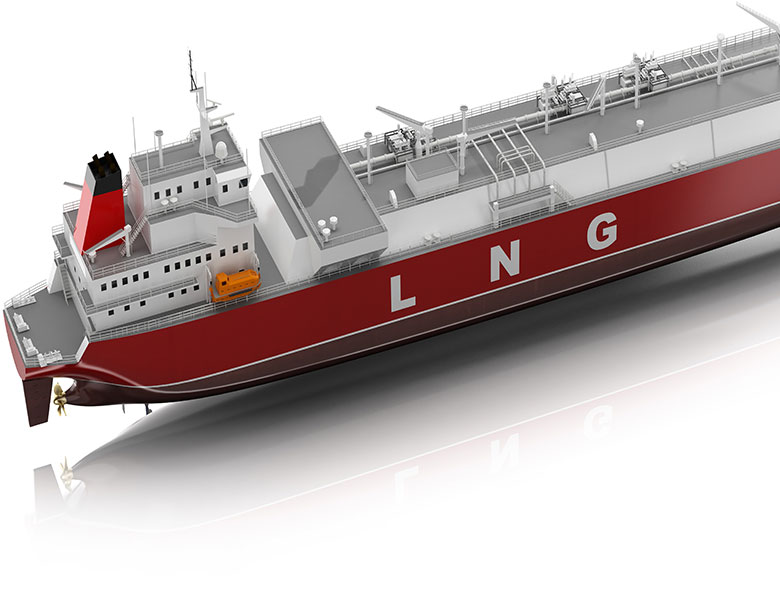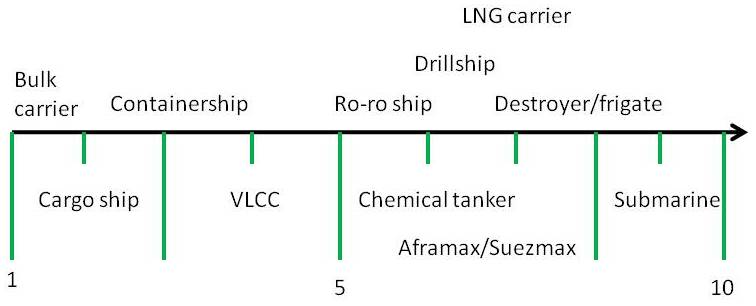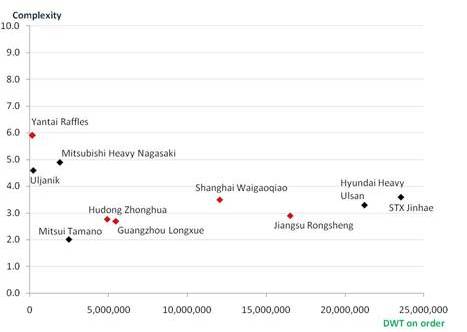Key policy implications:
- China’s growing proficiency in building massive ore carriers and oil tankers suggests that Chinese yards can physically fabricate ship hulls of up to supercarrier size.
- However, the ability to fashion a carrier’s hull has little bearing on the ability to build the ship’s internals and turn it into a floating airbase with planes, fuel, munitions, catapults, and at least several hundred personnel aboard.
- Building the internal components of the ship and then learning to operate this immensely complex vessel as part of a battle group will likely require many years of trial and error unrelated to China’s growing shipyard capacity.
The recent flurry of press reports describing the Chinese government’s apparent decision in 2009 to proceed with aircraft carrier development makes it worth examining closely the technical evolution occurring in China’s shipbuilding industry.
Chinese shipyards are working to boost their production of so-called “three high ship types.”[1] In essence, these are vessels that are considered to be “high technology, hard to build, and high value-added” (高技术, 高难度, 高附加值). State policy continues to emphasize the construction of more complex vessels. Scholars from Huadong Normal University and Shanghai Maritime University claim there is state support in the form of preferential loans and other financial measures for more advanced vessel types, including train carriers, 5,000 cubic meter LPG carriers, LNG carriers, and container ships larger than 3,000 TEU.
Commercial ships are typically less complex than military ships in terms of systems contained in the ship. The engineering space alone of a modern surface combatant contains more mechanical systems than an entire bulk carrier or tanker. The schematic below gives a basic illustration of complexity by ship type, with bulk carriers the least complex at a ranking of between 1 and 2, and submarines occupying the slot of highest complexity at 10 (Exhibit 1).
The exhibit’s number scale is not linear, and may be best thought of a something more akin to a pH scale, where each numerical step is separated by a logarithmic level of value from those before and after it. In essence, destroyers are typically much more complex than tankers and submarines are typically much more complex than destroyers. The ship complexity scale is based on our conversations with naval architects and ship designers. We acknowledge that even ships within the same type can vary in complexity based on features demanded by ship buyers, but believe that on the macro-level, the scale offers and accurate and easy to understand representation of ship complexity by type.
Exhibit 1: Ship complexity scale
1 lowest, 10 highest
Source: Interviews with industry experts, author’s estimates
Many Chinese writings suggest that higher complexity ships are also higher value-added and can yield higher profit margins. We believe prestige is also a strong driver. Successfully building higher-complexity vessels would enhance Chinese yards’ global brands and demolish the perception that they cannot competitively build advanced and high-quality vessels.
Chinese shipyards may also be motivated to increase their output of more specialty ship types in part because some are beginning to fear a protracted slowdown in the commodity ship market. For example, Qian Jianping, deputy manager of China Shipbuilding Industry Corp., believes a significant downturn in ship production could begin in 2012 as yards work through the current backlog of orders, many of which were placed during the commodity boom of 2005-08.[2]
Chinese yards appear to be particularly enthusiastic about the markets for LNG tankers, large container ships, and offshore drilling equipment. Its competitiveness is likely to rise in all three ship types due to strong domestic demand for LNG, logistics, and offshore oil and gas E&P. Chinese ship design institutes are responding to the call for production of indigenous high-complexity vessels. The Marine Research Institute of China (MARIC), for example, has produced designs for 308,000 DWT VLCCs, 9,200 TEU container ships, 315,000 DWT ore carriers, 300,000 DWT FPSO vessels, and a 3,000-meter semi-submersible drilling platform.[3]
Our analysis strongly suggests that the complexity of Chinese shipyards’ output slate is already basically on a par with that of major Japanese and Korean commercial yards. Korean yards produce many more ships, have more efficient production systems, and tend to have globally recognized brand specialties in certain ship types, such as LNG carriers, drillships, and very large crude carriers, but Chinese yards are improving rapidly. Hudong Zhonghua, Guangzhou Longxue, and Jiangsu Rongsheng have lower complexity rankings (between 2.0 and 3.0) than Shanghai Waigaoqiao (3.5), Hyundai Heavy Ulsan (3.3), and STX Jinhae (3.6). This is largely because their orderbooks focus primarily on lower complexity bulk carriers, while Waigaoqiao and the Korean yards have a large number of more complex tankers and specialty vessels on their orderbooks.
One intriguing fact is that the complexity of ships delivered from 2005-07 is actually higher for many of the Japanese and Korean yards than their orderbooks for 2010 through 2013. This stems in part from their aggressive pursuit of market opportunities driven by the rising demand (driven heavily by China) for iron ore, oil, and other bulk commodities, and the ensuing need for bulk carriers and tankers to move these goods. The fact that Chinese yards have been able to build market share steadily despite Korean and Japanese moves back into the commodity ship sector reflects the rising global competitiveness of China’s commercial shipbuilding industry.
While the yards profiled lost an average of 0.9 complexity points (out of 10 possible) between their 2005-07 and their 2010 and forward orderbooks, a premier Chinese yard, Shanghai Waigaoqiao, actually gained 0.9 complexity points, moving from 2.9 to 3.5. The main driver of this change is an increase in the proportion of very large crude carriers in the yard’s orderbook, as opposed to the less complex bulk carriers that previously dominated. Chinese yards’ are likely to become become strong competitors in the complex markets as well in the three-to-five year timeframe. The preferential procurement policies discussed earlier will help Chinese builders like Hudong Zhonghua hone their skills by supplying domestic shipping companies before plunging into the international high-end ship market.
Exhibit 2: Select global yards’ orderbooks rated by volume and ship complexity[1]
2010-forward
Source: Lloyd’s Seaweb, Author’s estimates
Subdividing the complexity of naval ship types precisely relative to each other is more challenging than doing so for commercial vessels due to the less-standardized designs and secrecy surrounding many systems. On a broad level, a nuclear ballistic missile submarine is likely the most complex vessel type to build, followed in order by nuclear attack submarines, diesel-electric submarines, aircraft carriers, amphibious assault vessels, and surface combatants such as destroyers and frigates.
We believe Chinese yards are currently not as competitive in the naval ship sector as their peers in South Korea and Japan. Unlike commercial building, the most advanced military shipbuilders are found in the U.S. and Russia (the only countries that can currently indigenously build vessels from across the submarine and surface combatant spectrum). Chinese yards also still lag EU military shipyards, which are also able to build a range of highly capable conventional submarines, surface combatants, and aircraft carriers/amphibious assault vessels such as the French Mistral-class.
How commercial advances might aid naval modernization
In the authors’ opinion, the cross-pollination between China’s civilian and military shipbuilding remains limited. China’s shipbuilding industry growth remains fundamentally driven by commercial opportunities, and a broader recognition that a robust commercial maritime presence will facilitate continued economic growth. Chinese shipyards have been responding to global ship demand patterns. China’s bulk commodity demand (crude oil, iron ore, grains, and coal) and containerized imports and exports have helped catalyze the dynamic growth in the global merchant marine over the past 5 years.
China’s dynamic shipbuilding sector and large merchant marine enhance comprehensive national power by fostering continued growth in China’s industrial base, and boosting China’s global maritime domain awareness. Chinese strategists from the state-sponsored think tank China Institutes of Contemporary International Relations (CICIR) support the concept of “comprehensive sea power,” under which a country must build a strong maritime commercial and intellectual foundation before it can become a true naval power.[4]
Commercial ship building industry advancements in China will help enhance the country’s ability to build advanced surface combatants and submarines incrementally, primarily through improving ship design and project execution capabilities. The area in which ongoing commercial ship construction improvements could boost China’s naval capability come in the area of logistical capacity enhancement. Oilers and other support ships are, broadly speaking, quite similar to their commercial cousins. Thus, yards that can rapidly turn out tanker and cargo ships could also quickly ramp up their construction of oilers and cargo vessels for the PLA Navy if ordered to do so.
Exhibit 3: Assessment of potential CIV-MIL shipbuilding technical carry-over
Source: Authors’ assessment
The actual components used in building military and commercial vessels are often quite different, as commercial ships are simpler and builders seek maximum “spin-on” from off the shelf systems in order to save time and construction costs. Systems integration challenges are much lower. One area where commercial gains will likely carry over comes from improvements in ship design and computer modeling and design technologies. The same basic techniques and concepts being used to make more fuel-efficient commercial ships such as the bulk carrier designs a number of Chinese yards are working on can help increase the range and speed of surface combatants.
China’s growing proficiency in building massive ore carriers and oil tankers implies that Chinese yards can physically fabricate ship hulls of up to supercarrier size. However, the ability to fashion a carrier’s hull has little bearing on the ability to build the ship’s internals and turn it into a floating airbase with planes, fuel, munitions, catapults, and at least several hundred personnel aboard. Building the internal components of the ship and then learning to operate this immensely complex vessel as part of a battle group will likely require many years of trial and error that cannot draw directly on China’s growing shipyard capacity.
Bigger dual use potential comes from use of the ships themselves. One scenario is that vessels are armed to a standard that makes them unsuited for high-intensity naval warfare, but equips them well for naval power projection against threats such as the Somali pirates. Recent Chinese news articles quote PLAN Rear Admiral Yin Zhuo as saying the Chinese navy needs patrol warships of 3,000-4,000 tons, and armed primarily with cannon and heavy machine guns. The vessels’ communication systems would not need to be as state of the art as those found on modern DDGs and frigates. Ships would also need a helipad to support air operations. If such ideas are adopted, Chinese shipyards would be able to build such vessels rapidly using modular construction and would likely also be able to do so at prices that are much lower than those of more advanced surface combatants. Despite the lower cost, the vessels would deliver a large boost to China’s maritime power projection capacity.
[1] The complexity ranking is derived from breaking down the yards’ orderbooks by ship type and deadweight tonnage, assigning complexity numbers from Exhibit 1, and then using the product of the complexity number and deadweight tonnage on order.
[1] “China’s shipbuilders seek to compete in the LNG carrier sector and break the South Korean monopoly,” China5e, 8 April 2010, http://www.china5e.com/show.php?contentid=89684.
[2] Hui Ching-hoo, “Chinese yards set of major slowdown,” Lloyd’s List, 23 August 2010, http://www.lloydslistdcn.com.au/archive/2010/august/23/chinese-yards-set-for-major-slowdown.
[3] MARIC, http://www.maric.com.cn/site04/site04_1.htm. Accessed 23 May 2010.
[4]杨明杰 [Yang Mingjie, ed.], 海上通道安全与国际合作 [Sea Lane Security and International Cooperation] (Beijing: 时事出版社 [Current Affairs Publishing House], 2005), 366.





